|
|

Image of Oreopolus palmae
VI Region, Junta de Toros camino hacia paso Agua Negra, km. 20, Chile
Altitude: 2600 - 3000 m. 11 04, 2007
|
|
| Species: | Oreopolus palmae (Clos) Ricardi | |
| Family: | Rubiaceae | |
| Order: | Rubiales | |
| Chilean Name: | ||
| English Name: | ||
| German Name: | ||
| Russian Name: | ||
| Record: | 0840 |
| About 3 Oreopolus in Chile and 3 in our data base. | |
| About 36 Rubiaceae in Chile and 17 in our data base. |
  |
|
|
|
|
| Not Frequent
Height: 15 cm. Good ornamental value (A) |
INTRODUCTION |
|
Image of Oreopolus palmae VI Region, Junta de Toros camino hacia paso Agua Negra, km. 20, Chile
|
DESCRIPTIONPlant type: Perennial Flower: Yellow, 5 petals Height: 15 cm.
|
|
Image of Oreopolus palmae VI Region, Junta de Toros camino hacia paso Agua Negra, km. 20, Chile
|
HABITATIn Chile this species grows in the following environmental conditions:
Habitat according to altitude: Medium altitude up to the timber line
Watering conditions: Somewhat dry areas where the drought may last 3 - 5 months. Precipitations of 400 - 800 mm. are concentrated in winter.
Light conditions: Fully exposed to the sun. Level areas or slopes facing north.
|
|
Image of Oreopolus palmae VI Region, Junta de Toros camino hacia paso Agua Negra, km. 20, Chile
|
USESGood ornamental value (A)
|
|
Image of Oreopolus palmae VI Region, Junta de Toros camino hacia paso Agua Negra, km. 5 -8, Chile
|
GROWING TIPSThis species has the following hardiness: USDA Hardiness Zone 9. The plant does not tolerate snow, but can tolerate occasional freezing spells of about - 5° C (the typical morning frost of central Chile).
If you are interested in purchasing seeds of this or similar species, please go to our On-line Seeds Shop. |
|
More photos (13) of Oreopolus palmae (Clos) Ricardi available here |
|
More species from the same Rubiaceae family in our data base: Cruckshanksia hymenodon var. hymenodon Galium aparine (lengua de gato) Nertera granadensis (Rucachucao / Coralito / Quelligüenchucaou) Oreopolus glacialis (Oreopolo) Oreopolus palmae |




